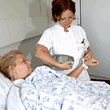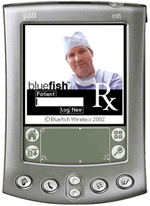 |
|
|
75 Percent Favor Barcodes on Prescription Medicines; Nursing Shortage Seen as Most Serious Health Hazard VALLEY FORGE, Pa., Feb 25, 2003 -- Twenty-three percent of Americans -- or nearly one in four -- say they or a family member have received the wrong medication at some point from a healthcare professional, according to the latest AmerisourceBergen Index released today. The quarterly telephone survey was conducted from January 23-26, 2003 by Opinion Research Corporation on behalf of AmerisourceBergen, the largest pharmaceutical services company in the United States dedicated solely to the pharmaceutical supply channel. The margin of error is plus or minus three percent. The survey of 1033 adults nationwide explored a variety of issues related to patient safety, including the best ways to prevent medication errors, safety hazards in hospitals, and the priority hospitals place on patient safety. New Technologies Score High Marks
In a related question, barcode scanning of medications came in second out of a list of five ways to increase medication-dispensing accuracy. Twenty- four percent of all respondents selected this choice. Interest was even higher among 45-to-54-year-olds, with 32 percent of these respondents choosing this option.
Greater use of automated technologies to count pills and check prescriptions before they are dispensed placed third, with 17 percent of respondents picking this. At the bottom of the list were "more pharmacists" (11 percent) and "more pharmacy technicians" (8 percent). However, when respondents were asked whether the government should provide low-interest loans to pharmacy students to address the current pharmacist shortage and encourage more people to enter the field, 83 percent of those surveyed said yes. Only 15 percent said no. Hospital Commitment to Safety Viewed Favorably Despite concerns over patient safety, 93 percent of respondents said they believed hospitals placed a priority on reducing medication errors and medical mistakes, although they expressed this opinion to varying degrees. Thirty- three percent said they thought hospitals viewed this as "a top priority," while 41 percent said it was important, but not a top priority. Eighteen percent said hospitals considered this "somewhat important." However, only five percent said hospitals did not consider it important to reduce medical or medication errors. Uniform Safety Protocols Favored With regard to other solutions for ensuring greater patient safety, 80 percent of respondents said they thought the healthcare industry would benefit from the adoption of uniform safety protocols prior to administering medication or performing a medical procedure, such as a checklist or other measures. When asked why they thought uniform safety procedures had not yet been adopted, 47 percent cited cost. Twenty-one percent said it was disagreement over how to accomplish this goal, while 15 percent attributed it to a resistance to change. Only 10 percent selected physician independence as the reason. Most Serious Hospital Hazard
About AmerisourceBergen AmerisourceBergen (NYSE: ABC) is the largest pharmaceutical services company in the United States dedicated solely to the pharmaceutical supply channel. It is the leading distributor of pharmaceutical products and services to the hospital systems/acute care market, physician's offices, alternate care and mail order facilities, independent community pharmacies, and regional chain pharmacies. The Company is also a leader in the institutional pharmacy marketplace. With more than $40 billion in annualized operating revenue, AmerisourceBergen is headquartered in Valley Forge, PA, and employs more than 13,000 people. For more information go to www.amerisourcebergen.com.
|
|||||||||||

